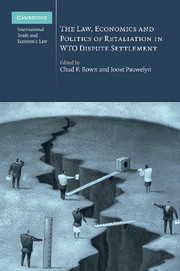Book contents
- Frontmatter
- Contents
- List of tables and figures
- Contributors
- Introduction: trade retaliation in WTO dispute settlement: a multi-disciplinary analysis
- PART I Background and goal(s) of WTO retaliation
- 1 The nature of WTO arbitrations on retaliation
- 2 The calculation and design of trade retaliation in context: what is the goal of suspending WTO obligations?
- 3 Extrapolating purpose from practice: rebalancing or inducing compliance
- PART II A legal assessment after ten arbitration disputes
- PART III An economic assessment after ten arbitration disputes
- PART IV The domestic politics and procedures for implementing trade retaliation
- PART V Problems and options for reform
- PART VI New frontiers and lessons from other fields
- Index
2 - The calculation and design of trade retaliation in context: what is the goal of suspending WTO obligations?
Published online by Cambridge University Press: 26 February 2010
- Frontmatter
- Contents
- List of tables and figures
- Contributors
- Introduction: trade retaliation in WTO dispute settlement: a multi-disciplinary analysis
- PART I Background and goal(s) of WTO retaliation
- 1 The nature of WTO arbitrations on retaliation
- 2 The calculation and design of trade retaliation in context: what is the goal of suspending WTO obligations?
- 3 Extrapolating purpose from practice: rebalancing or inducing compliance
- PART II A legal assessment after ten arbitration disputes
- PART III An economic assessment after ten arbitration disputes
- PART IV The domestic politics and procedures for implementing trade retaliation
- PART V Problems and options for reform
- PART VI New frontiers and lessons from other fields
- Index
Summary
[I]t is not completely clear what role is to be played by the suspension of obligations in the DSU and a large part of the conceptual debate that took place in these proceedings could have been avoided if a clear ‘object and purpose’ were identified. (US–Byrd arbitration, paragraph 6.4)
Introduction
This volume concerns the calculation and design of trade retaliation in response to continued non-compliance with the WTO treaty. In subsequent chapters, detailed questions related to this broad topic are examined. One red line that frequently runs through these assessments of legal or economic detail (be it the application of the ‘equivalence’ standard, the choice of ‘counterfactual’, the benchmark to determine ‘nullification’ or the selection of products to target) regards the purpose or goal(s) of suspending WTO concessions. When the WTO permits, or a WTO member engages in, trade retaliation in response to continued non-compliance, what is it trying, or can it legitimately hope, to achieve? This question, as we examine it here, does not relate to what the retaliating country's preferences are in this situation (obviously, as complainant, its first goal is most likely to be compliance by the defendant). The question is rather what the drafters of the Dispute Settlement Understanding (DSU) as a whole (drafting as both potential complainants and potential defendants) intended with the instrument of WTO retaliation. Although clarification of this purpose or goal surely does not solve all problems, nor is it able to provide exact numbers, 4 it can offer crucial insights as a contextual element.
- Type
- Chapter
- Information
- Publisher: Cambridge University PressPrint publication year: 2010
- 3
- Cited by



